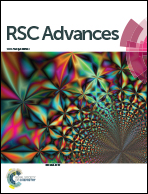Identification of high affinity peptides for capturing norovirus capsid proteins†
Abstract
Here, we present a platform where novel short and linear peptide motifs that enable binding to norovirus capsid proteins are selected by M13 phage display. The best peptide which recognizes recombinant norovirus 6H-P2 proteins has a sequence of ‘QHIMHLPHINTL’ and the apparent dissociation binding constants (Kd,app) of the selected peptides was found to be 185 nM of affinity.


 Please wait while we load your content...
Please wait while we load your content...